Picture this: A potential customer sees your LinkedIn ad during their morning coffee. They visit your website but don’t convert. Three days later, they receive your email newsletter. They click through but still don’t buy. Finally, they see your Google ad while researching solutions. This time, they convert.
This journey happens millions of times daily. Modern customers don’t follow straight paths to purchase. They bounce between channels, devices, and multiple touchpoints before reaching their actual decision.
Most businesses struggle with disconnected marketing efforts. Their email team works separately from their social media team. Their website analytics don’t talk to their CRM. This creates gaps where potential customers fall through.
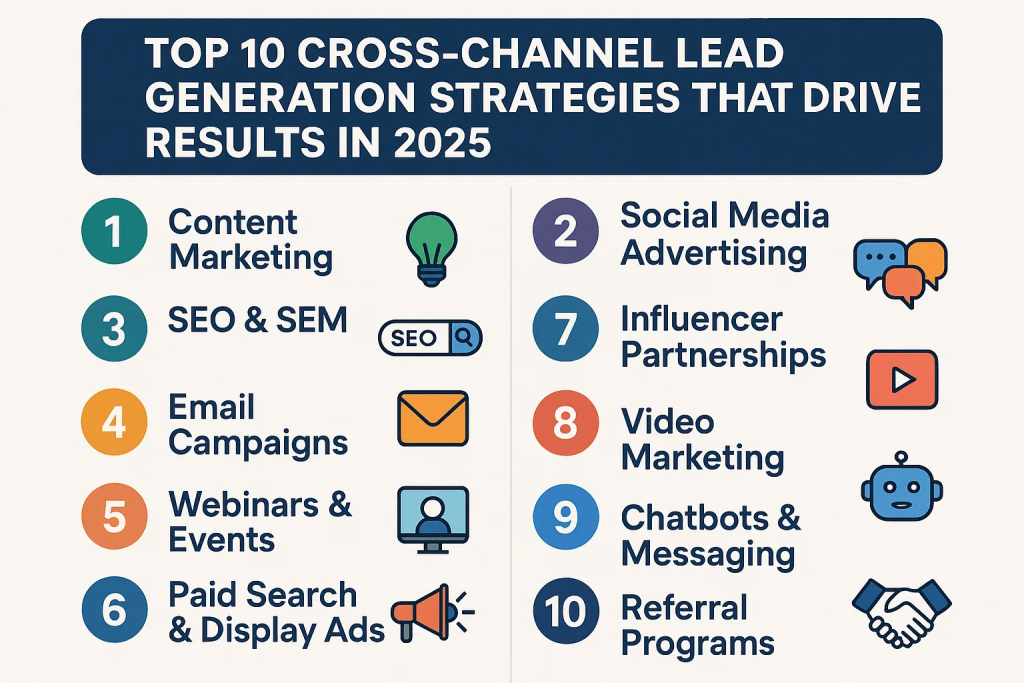
This is where Cross channel lead generation helps in solving such problems by connecting all your marketing channels into one unified system. Cross channels is the process through which your customers get consistent messages across every touchpoint. You capture more leads and convert them faster.
Through this guide you will understand the Top 10 Cross Channel Lead Generation Strategies across multiple channels that will help you build a system that captures more qualified customers.
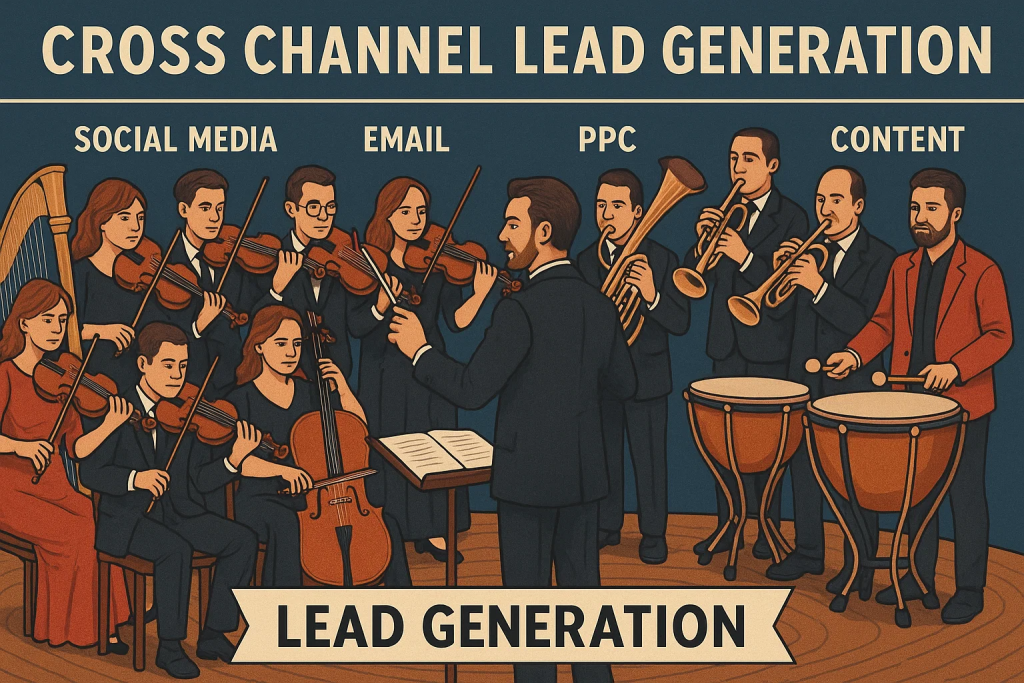
If you are looking for one system that targets multi[ple channels then Cross Channel Lead Generation is something you need.
Let’s take a quick example to understand: symphony orchestra for instance, one conductor ensures every instrument plays in harmony. Similarly, Cross Channels align different marketing channels to deliver consistent messages, guiding customers smoothly toward conversion.
This approach differs from traditional marketing in three key ways:
Cross Channel vs Multi-Channel Marketing
Multi-channel marketing uses several channels but keeps them separate. Each channel has its part to play individually with its own goals and metrics. Cross channel marketing connects these channels through shared data and unified strategies.
Multi-channel lead generation casts a wide net, but cross-channel lead generation goes further by creating seamless funnels. Cross-channel lead generation touches every touchpoint and works together to move customers from closer to conversion.
Today’s B2B buyers interact with 6-8 touchpoints before making purchase decisions. They research mobile devices during commutes. They attend webinars from home offices. They read emails on tablets during lunch breaks.
Your prospects expect consistent experiences across all these touchpoints. When messages don’t align, trust drops and conversions suffer.
Current market statistics reveal compelling trends:
The 10 strategies in this guide address the most critical aspects of cross channel success. They’re based on real-world results from companies that have mastered integrated lead generation.
Map every interaction your prospects have with your brand across all channels. This foundation strategy guides all other cross channel efforts.
Why it works: Journey mapping reveals gaps where prospects drop off or get confused. You discover which channel combinations work best for different buyer personas.
How to implement:
Start by interviewing your current customers about their buying process. What content did they consume? Which channels influenced their decision? How did they prefer to communicate with your team?
Create visual journey maps showing how prospects move between channels. Include all touchpoints:
Identify the most critical touchpoints that predict conversion. Focus your integration efforts on these high-impact moments.
Pro tip: Update your journey maps quarterly as customer behavior changes and new channels emerge.
Traditional lead scoring only looks at single-channel actions. Cross channel scoring creates more accurate qualification by combining behaviors from all touchpoints.
Why it works: Multiple data points provide clearer pictures of buying intent. A prospect who downloads your whitepaper, attends your webinar, and visits your pricing page shows serious interest.
How to implement:
Create scoring frameworks that weight different actions based on their predictive value:
You need to set up an automated system that sets an alarm and triggers alert sales when leads reach qualification thresholds. You can create different scoring models for different customers and their needs considering market segments.
Best practice: Review and adjust scoring weights quarterly based on actual conversion data.
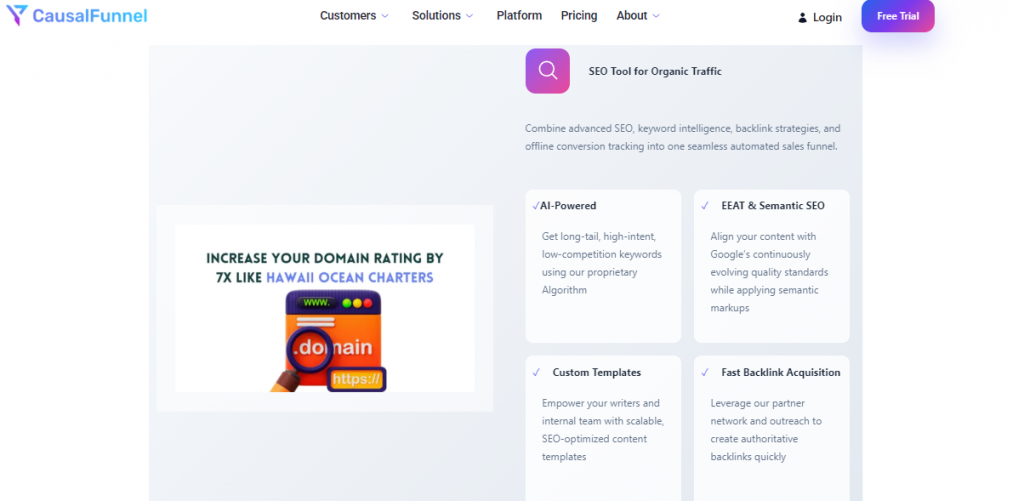
Create content once and distribute it strategically across multiple channels.
Why it works: Syndication ensures your message reaches audiences wherever they consume content.
How to implement:
SEO Tools provide AI-powered keyword insights that identify trending search topics. When you syndicate content, these insights ensure your pieces rank organically and capture intent-driven traffic.
Why it works: Different prospects prefer different content formats and channels. Syndication ensures your message reaches audiences wherever they consume content.
How to implement:
Develop content hubs around key topics your prospects care about. Transform core content into multiple formats:
Plan distribution timelines that maximize reach without overwhelming your audience. Space content releases across different channels throughout the week.
Content distribution calendar example:
Follow customers across all the channels based on their previous interactions.
Why it works: your customers need exposure based on their needs and they feel ready to buy. Retargeting ensures your brand stays top-of-mind and builds familiarity.
How to implement:
Example with CausalFunnel’s Ads Optimizer: Imagine a SaaS company targeting enterprise clients. Prospects visit the pricing page but don’t convert.
With Ads Optimizer, automatically targets those same decision-makers with personalized LinkedIn ads, followed by an email offering a case study. This cross-channel flow keeps the conversation alive and nudges prospects toward booking a demo, all while maximizing ROI.
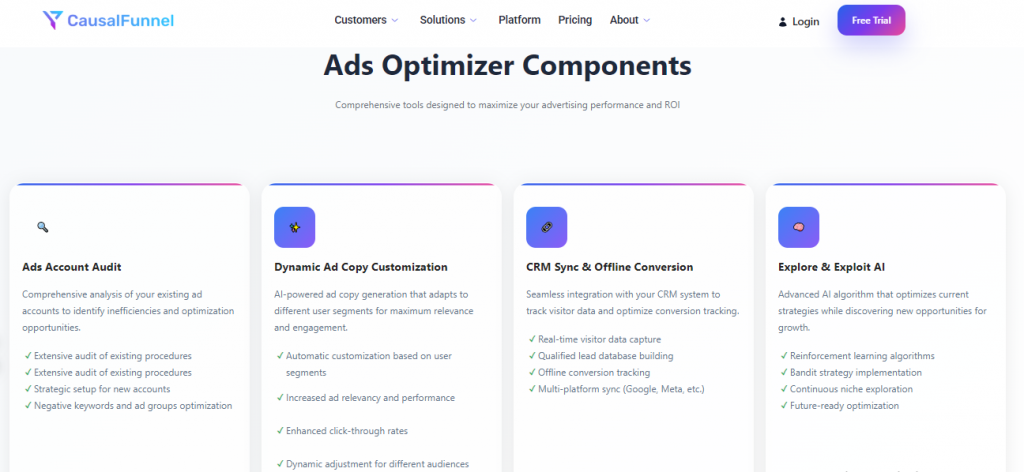
Why it works: Most prospects need multiple exposures before converting. Cross channel retargeting ensures you stay visible throughout their research process.
How to implement:
Set up pixel tracking on your website and landing pages. Create audience segments based on specific behaviors:
Develop retargeting sequences that provide value rather than just promoting your products:
For website visitors: Educational content about their challenges
For content downloaders: Related resources and case studies
For email subscribers: Personalized recommendations and exclusive offers
For webinar attendees: Follow-up resources and implementation guides
Use different channels for follow-up to avoid overwhelming prospects on single platforms.
Break down silos between marketing and sales teams by sharing customer data, insights across both departments.
How to implement:
Implement systems that give both teams access to complete customer profiles:
Create regular alignment meetings between marketing and sales:
Establish shared metrics that both teams contribute to and benefit from achieving.
Why it works: Aligned teams create better customer experiences. Sales conversations improve when reps understand prospect marketing interactions. Marketing campaigns improve when teams learn what messaging resonates with buyers.
Create automated sequences that adapt to prospect behavior and preferences across different channels.
Why it works: Personalization increases engagement and conversion rates. Multi-channel sequences ensure your message reaches prospects through their preferred communication methods.
How to implement:
Segment your audience based on behavior, demographics, and channel preferences. Create different sequence paths for different segments:
For early-stage prospects:
For middle-stage prospects:
For late-stage prospects:
Use marketing automation to trigger different sequence paths based on prospect actions and engagement levels.
Coordinate marketing efforts around high-value target accounts using multiple channels to engage different stakeholders within each organization.
Why it works: B2B purchases involve multiple decision-makers. ABM ensures you reach all stakeholders with relevant messaging through their preferred channels.
How to implement:
Identify high-value target accounts based on ideal customer profiles. Research each account to understand:
Create account-specific campaigns across multiple channels:
Coordinate timing across all channels to create consistent experiences. When one stakeholder engages, trigger relevant outreach to other decision-makers at the same company.
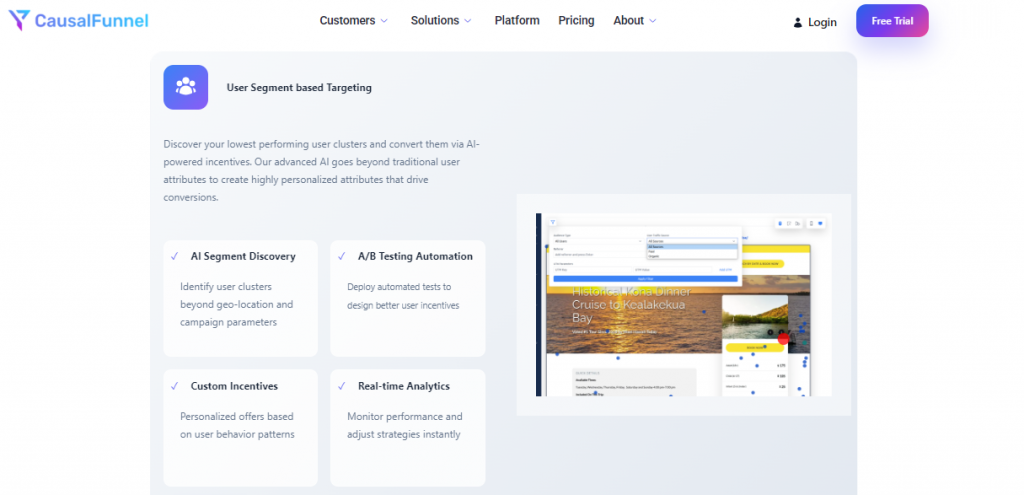
Leverage customer success stories and testimonials. CausalFunnel Visitor Incentives encourage satisfied customers to leave reviews or share stories, amplifying advocacy across multiple channels.
Why it works: Social proof reduces risk and accelerates decisions.
How to implement:
Why it works: Prospects trust peer recommendations more than marketing messages. Social proof reduces perceived risk and accelerates buying decisions.
How to implement:
Collect customer success stories in multiple formats:
Distribute social proof strategically across channels:
Email campaigns: Include relevant customer quotes in newsletters and nurturing sequences Social media: Share customer success stories and tag satisfied clients
Website: Feature testimonials prominently on key pages
Sales presentations: Use industry-specific case studies for different prospects
Paid advertising: Create ads featuring customer testimonials and results
Create customer advocacy programs that encourage satisfied clients to share their experiences across multiple platforms.
Use events, webinars, and industry activities as catalysts for integrated marketing campaigns across multiple channels.
Why it works: Events create natural conversation starters and engagement opportunities. Cross-channel promotion maximizes attendance and follow-up conversion rates.
How to implement:
Plan integrated campaigns around key events:
Pre-event promotion:
During-event engagement:
Post-event follow-up:
Create event-specific landing pages that capture leads and segment audiences for targeted follow-up sequences.
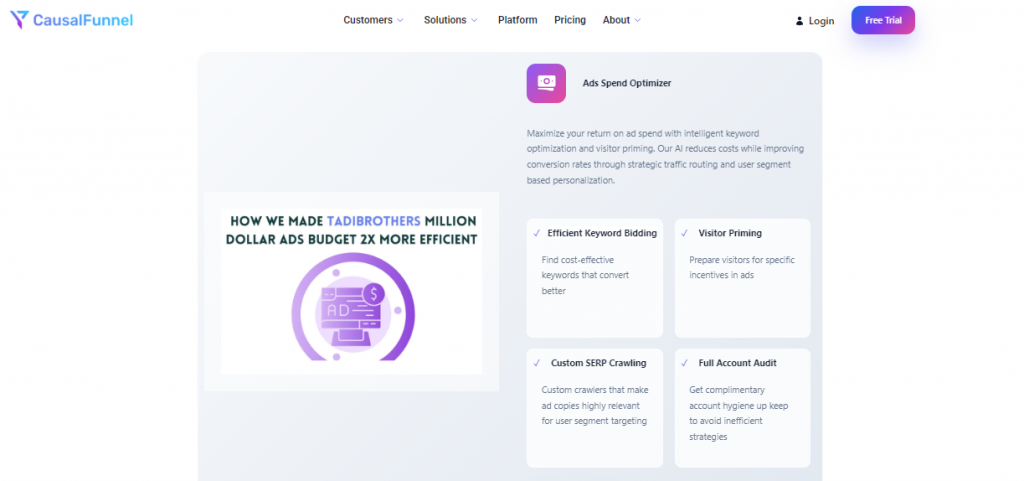
Use AI to optimize performance, personalize experiences, and automate tasks. Ads Optimizer manages ad spend across Google, Meta, and LinkedIn with precision, while SEO Tools ensure content ranks for high-intent searches. For example, a cosmetics brand could target “cruelty-free makeup set” with Ads Optimizer, then personalize retargeting nudges for eco-conscious shoppers, turning disconnected ads into one cohesive funnel.
How to implement:
Why it works: AI processes data faster than humans and identifies patterns that improve campaign performance. Automation ensures consistent execution across all channels.
How to implement:
Start with simple AI applications and expand as you gain experience:
Email optimization:
Website personalization:
Advertising optimization:
Lead scoring enhancement:
Choose AI tools that integrate with your existing marketing stack. Focus on applications that solve specific problems rather than implementing AI for its own sake.
Solution: Start with simple integrations between your most important tools. Use native integrations when available. Consider customer data platforms for complex environments.
Solution: Establish regular cross-functional meetings. Create shared goals and metrics. Use project management tools to coordinate campaign launches.
Solution: Begin with pilot projects that demonstrate value. Use success stories to secure additional resources for broader implementation.
Solution: Calculate ROI based on improved lead quality and conversion rates. Start with free or low-cost integration tools before investing in enterprise solutions.
Cross channel lead generation continues evolving with new technologies and changing customer expectations. Stay competitive by:
Monitor industry trends while focusing on proven fundamentals. New technologies should enhance your existing cross channel foundation rather than replace it entirely.
These 10 cross channel lead generation strategies transform disconnected marketing efforts into unified systems that generate better leads and drive more revenue. Success comes from implementing these strategies systematically while maintaining focus on customer experience and business results.
Your next steps:
The businesses that master these cross channel strategies will capture more market share as competition intensifies. Start implementing today to build competitive advantages that compound over time.
Your prospects already engage across multiple channels. These 10 strategies help you meet them wherever they are and guide them smoothly toward conversion.
Empowering businesses to optimize their conversion funnels with AI-driven insights and automation. Turn traffic into sales with our advanced attribution platform.



